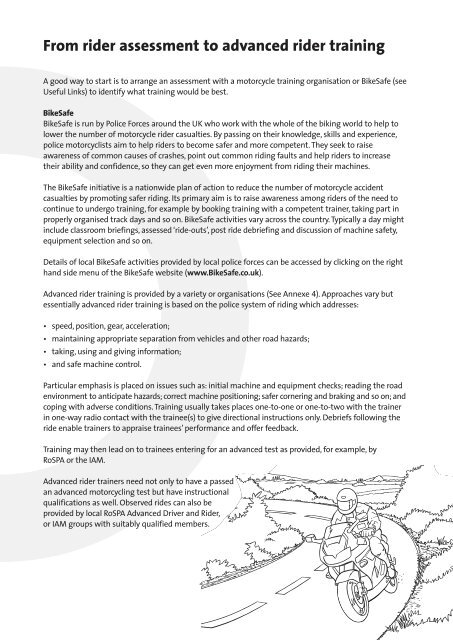Safer Motorcycling Through Work - Network - Motorcycle Action Group
Safer Motorcycling Through Work - Network - Motorcycle Action Group
Safer Motorcycling Through Work - Network - Motorcycle Action Group
Create successful ePaper yourself
Turn your PDF publications into a flip-book with our unique Google optimized e-Paper software.
From rider assessment to advanced rider training<br />
A good way to start is to arrange an assessment with a motorcycle training organisation or BikeSafe (see<br />
Useful Links) to identify what training would be best.<br />
BikeSafe<br />
BikeSafe is run by Police Forces around the UK who work with the whole of the biking world to help to<br />
lower the number of motorcycle rider casualties. By passing on their knowledge, skills and experience,<br />
police motorcyclists aim to help riders to become safer and more competent. They seek to raise<br />
awareness of common causes of crashes, point out common riding faults and help riders to increase<br />
their ability and confidence, so they can get even more enjoyment from riding their machines.<br />
The BikeSafe initiative is a nationwide plan of action to reduce the number of motorcycle accident<br />
casualties by promoting safer riding. Its primary aim is to raise awareness among riders of the need to<br />
continue to undergo training, for example by booking training with a competent trainer, taking part in<br />
properly organised track days and so on. BikeSafe activities vary across the country. Typically a day might<br />
include classroom briefings, assessed ‘ride-outs’, post ride debriefing and discussion of machine safety,<br />
equipment selection and so on.<br />
Details of local BikeSafe activities provided by local police forces can be accessed by clicking on the right<br />
hand side menu of the BikeSafe website (www.BikeSafe.co.uk).<br />
Advanced rider training is provided by a variety or organisations (See Annexe 4). Approaches vary but<br />
essentially advanced rider training is based on the police system of riding which addresses:<br />
• speed, position, gear, acceleration;<br />
• maintaining appropriate separation from vehicles and other road hazards;<br />
• taking, using and giving information;<br />
• and safe machine control.<br />
Particular emphasis is placed on issues such as: initial machine and equipment checks; reading the road<br />
environment to anticipate hazards; correct machine positioning; safer cornering and braking and so on; and<br />
coping with adverse conditions. Training usually takes places one-to-one or one-to-two with the trainer<br />
in one-way radio contact with the trainee(s) to give directional instructions only. Debriefs following the<br />
ride enable trainers to appraise trainees’ performance and offer feedback.<br />
Training may then lead on to trainees entering for an advanced test as provided, for example, by<br />
RoSPA or the IAM.<br />
Advanced rider trainers need not only to have a passed<br />
an advanced motorcycling test but have instructional<br />
qualifications as well. Observed rides can also be<br />
provided by local RoSPA Advanced Driver and Rider,<br />
or IAM groups with suitably qualified members.


